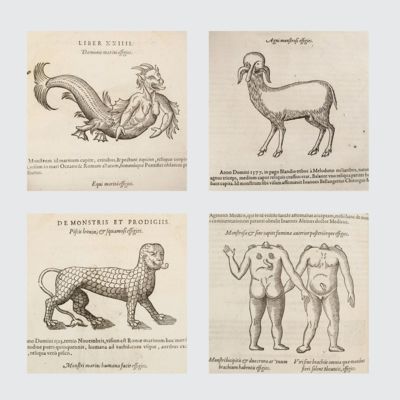Paré, A.
Opera Ambrosii Parei Regis Primarii et Parisiensis chirurgi. A docto viro plerisque locis recognita: et Latinitate donata, Iacobi Guillemeau, Regij & Parisiensis chirurgi labore & diligentia. Ad clarissimum virum Marcum Mironem Regis Archiatrum dignissimum.
Paris, Iacobus Du-puys [Du-Puys; Dupuys], 1582. Folio (33.1 x 21.1 cm). Title page, [xi], 884, [xli] pp.; large woodcut portrait of the author, numerous woodcuts in the text, including many that are quite large and detailed, wood-engraved capitals and headpieces. 17th-century speckled calf. Spine with six raised, gilt-ornamented bands; compartments with gilt-lined borders and floral vignettes; gilt-rolled ornamental band at head and foot, and gilt title. All edges speckled red.
First Latin edition of a work first published in French in 1575, however, translated from the second, improved, 1579 edition, and adorned with many fine woodcuts. The fine woodcuts show, as accurate as possible, human anatomical details, and medical instruments, technology and techniques, of which many were invented or improved by Paré. Included is a lot on monsters, both teratological and mythological, with fine, large woodcuts of several marine monsters, such as the famous sea monk, the sea bishop and other fantastical sea creatures, dragons, mermaids, monsters with human heads, but animal bodies. Some are extremely curious with multiple eyes on the belly or the back, legs, arms, or monstrosities entirely without heads, etc. Also, various exotic animals, including reptiles, snails, unicorns, an elephant, rhinoceros, and many more. Another well-illustrated chapter deals with distillation. As note by Durling (p. 452), it is known that, despite the title, Guillemeau is not the translator. This work is not uncommon, but complete copies are rare. For instance, the Wellcome Collection in London has three copies, but none of these is complete, whereas our copy is complete, and in a very fine state indeed. Ambroise Paré (c. 1510-1590) was a French barber surgeon who served in that role for kings Henry II, Francis II, Charles IX and Henry III. He is considered one of the fathers of surgery and modern forensic pathology and a pioneer in surgical techniques and battlefield medicine, especially in the treatment of wounds. He was also an anatomist, invented several surgical instruments, and was a member of the Parisian barber surgeon guild. Moreover, he was an early debunker of pseudoscience. In 1567, Ambroise Paré described an experiment to test the properties of bezoar stones. "At the time, the stones were commonly believed to be able to cure the effects of any poison, but Paré believed this to be impossible. It happened that a cook at Paré's court was caught stealing fine silver cutlery and was condemned to be hanged. The cook agreed to be poisoned instead, on the condition that he would be given a bezoar straight after the poison and go free if he survived. The stone did not cure him, and he died in agony seven hours after being poisoned. Thus, Paré had proved that bezoars could not cure all poisons" (Wikipedia), see pp. 609-610 of the book. Some mild, marginal staining to pp. 651-658, but nearly completely clean, with strong impressions, which is highly unusual. An excellent, clean and complete copy. Brunet 4, pp. 366-367 (also mentioning a Frankfurt 1594 edition); Durling, 3531 (describing an imperfect copy); Garrison-Morton, 5565, note (Latin translation of the second French edition).




